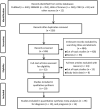Circular RNAs as Diagnostic and Prognostic Indicators of Colorectal Cancer: A Pooled Analysis of Individual Studies
- PMID: 35369570
- PMCID: PMC8967936
- DOI: 10.3389/pore.2022.1610037
Circular RNAs as Diagnostic and Prognostic Indicators of Colorectal Cancer: A Pooled Analysis of Individual Studies
Abstract
Background: Circular RNAs (circRNAs) have proven as a special subset of endogenous RNAs that are implicated in the tumorigenesis of various cancers. This study sought to evaluate the role of circRNAs in the diagnosis and prognosis of colorectal cancer (CRC). Methods: The online databases were searched for collecting relevant studies on circRNAs as diagnostic and prognostic biomarkers of CRC. Two researchers independently screened literature, extracted data, and evaluated the bias and risks of included studies. The diagnostic and prognostic indicators were merged and analyzed using STATA 12.0 software, and sources of heterogeneity were traced by the sensitivity analysis and the meta-regression test. Results: A total of 29 articles representing 2639 CRC patients were included. The pooled sensitivity, specificity, and area under the curve (AUC) of circRNAs in differentiating CRC from non-tumor control were 0.75 (95% CI: 0.69-0.80) and 0.74 (95% CI: 0.69-0.78) and 0.81, respectively. The survival analysis showed that up-regulations of up-regulated circRNAs were significantly related to dismal survival in CRC patients (HR = 2.38, p < 0.001). A stratified analysis showed that the comprehensive diagnostic value of up-regualted circRNAs in CRC was higher than that of down-regualted circRNAs (AUC: 0.83 vs. 0.77; Z test, p < 0.05). The efficacy of tissue-derived circRNAs in the diagnosis of CRC was equal to that of plasma/serum-derived ones (AUC: 0.81 vs. 0.82; Z test, p > 0.05). Conclusion: Abnormally expressed circRNAs as auxiliary biomarkers present underlying value in the diagnosis and prognosis prediction of CRC.
Keywords: circular RNA; colorectal cancer; diagnosis; pooled analysis; prognosis.
Copyright © 2022 Long, Xu, Ding, Huang and Ji.
Conflict of interest statement
The authors declare that the research was conducted in the absence of any commercial or financial relationships that could be construed as a potential conflict of interest.
Figures





Similar articles
-
A pair-wise meta-analysis highlights circular RNAs as potential biomarkers for colorectal cancer.BMC Cancer. 2019 Oct 15;19(1):957. doi: 10.1186/s12885-019-6136-9. BMC Cancer. 2019. PMID: 31615475 Free PMC article.
-
Diagnostic value of circular RNAs in colorectal cancer: A systematic review and meta-analysis.Pathol Res Pract. 2019 Dec;215(12):152680. doi: 10.1016/j.prp.2019.152680. Epub 2019 Oct 3. Pathol Res Pract. 2019. PMID: 31635986
-
Prognostic and diagnostic value of circRNA expression in colorectal carcinoma: a meta-analysis.BMC Cancer. 2020 May 19;20(1):448. doi: 10.1186/s12885-020-06932-z. BMC Cancer. 2020. PMID: 32429931 Free PMC article.
-
CircRNAs as promising biomarker in diagnostic and prognostic of lung cancer: An updated meta-analysis.Genomics. 2021 Jan;113(1 Pt 1):387-397. doi: 10.1016/j.ygeno.2020.12.013. Epub 2020 Dec 14. Genomics. 2021. PMID: 33326833
-
Abnormally Expressed Circular RNAs are Promising Biomarkers for Diagnosis of Hepatocellular Carcinoma: a Meta-Analysis.Clin Lab. 2019 Nov 1;65(11). doi: 10.7754/Clin.Lab.2019.190354. Clin Lab. 2019. PMID: 31710441
Cited by
-
Genomic and Transcriptomic Research in the Discovery and Application of Colorectal Cancer Circulating Markers.Int J Mol Sci. 2023 Aug 3;24(15):12407. doi: 10.3390/ijms241512407. Int J Mol Sci. 2023. PMID: 37569782 Free PMC article. Review.
-
Prognostic significance of a signature based on senescence-related genes in colorectal cancer.Geroscience. 2024 Oct;46(5):4495-4504. doi: 10.1007/s11357-024-01164-6. Epub 2024 Apr 25. Geroscience. 2024. PMID: 38658505 Free PMC article.
References
MeSH terms
Substances
LinkOut - more resources
Full Text Sources
Medical

